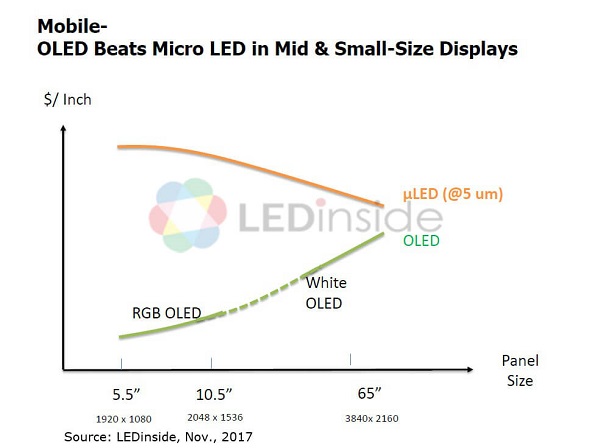Much hope has been put in Micro LED to drive the next generation display technology, but there isn’t a concrete date to see it commercialized yet. The production cost is still high, and development of mass transfer technologies gets stuck. Even Apple is rumoured to have downsized its secret team that develops Micro LED in Taiwan.
 |
|
(Image: public domain CC0) |
Every move Apple makes is under the limelight. The news circulated quickly among the industry. That also tells the fact that the whole industry is struggling, especially developing mid/small sized Micro LED displays.
 |
|
Apple's Micro LED research center in Taiwan (Image: Seeking Alpha) |
In fact, what the industry has to conquer to commercialize Micro LED display technology is not only limited to technological challenges. It also has to control the production cost, making it as competitive as those of other display technologies.
In the realm of mid/small sized displays, OLED seems to prevail and its production is rather mature. Judging by cost per unit area, each inch of OLED now costs much less than that of Micro LED. LEDinside charts the comparison as below.
Sony and Samsung Eye Opportunities in the Large-sized Display Market
Even though it appears to be unlikely for Micro LED to be commercialized in the mid/small-sized display market, it does has a chance to in the large-sized display market. In terms of OLED display development, yields of OLED displays over 65 inches are yet to be good enough. Cost structure wise, the gap between the cost per unit area and that of OLED is narrowing.
LEDinside also thinks video wall could be another segment where Micro LED can shine. If video walls are going to ultimately achieve 4K or 8K resolution, more LED chips will be needed, which might cause a cost rise in both materials and manufacturing. However, adopting Micro LEDs can effectively improve the resolution and reduce the cost once manufacturers master the mass transfer process. That is also why Sony and Samsung both buckle down to the development of Micro LED technology for large-sized displays.
Judging by Sony’s progress, it launched Micro LED-like displays that drew a lot of market attention. Samsung is also reportedly attempting to introduce LED displays to cinemas. In comparison to regular film projection leading to poor contrast, and dark images when viewed with 3D glasses, cinema LED screens, which Samsung intends to manufacture, would not arouse those problems. Starting from that, Samsung also plans Mini or Micro LED cinema displays in the future.
While Micro LED technology still takes time to take hold, some companies release Mini LED-based products as a transition. According to LEDinside’s research, Mini LED is between standard LED and Micro LED in terms of size, which is able to produce using incumbent technologies and equipment. In particular, the integration of Mini LED with flexible backplanes enables curved backlight modules that can be first used in smartphones, TVs, automotive displays, and gaming laptops.
All considered, despite the fact that Micro LED currently sees little chance in the mid/small-sized display market, it is still worth anticipating to see those major companies roll out their large-sized Micro LED products.














